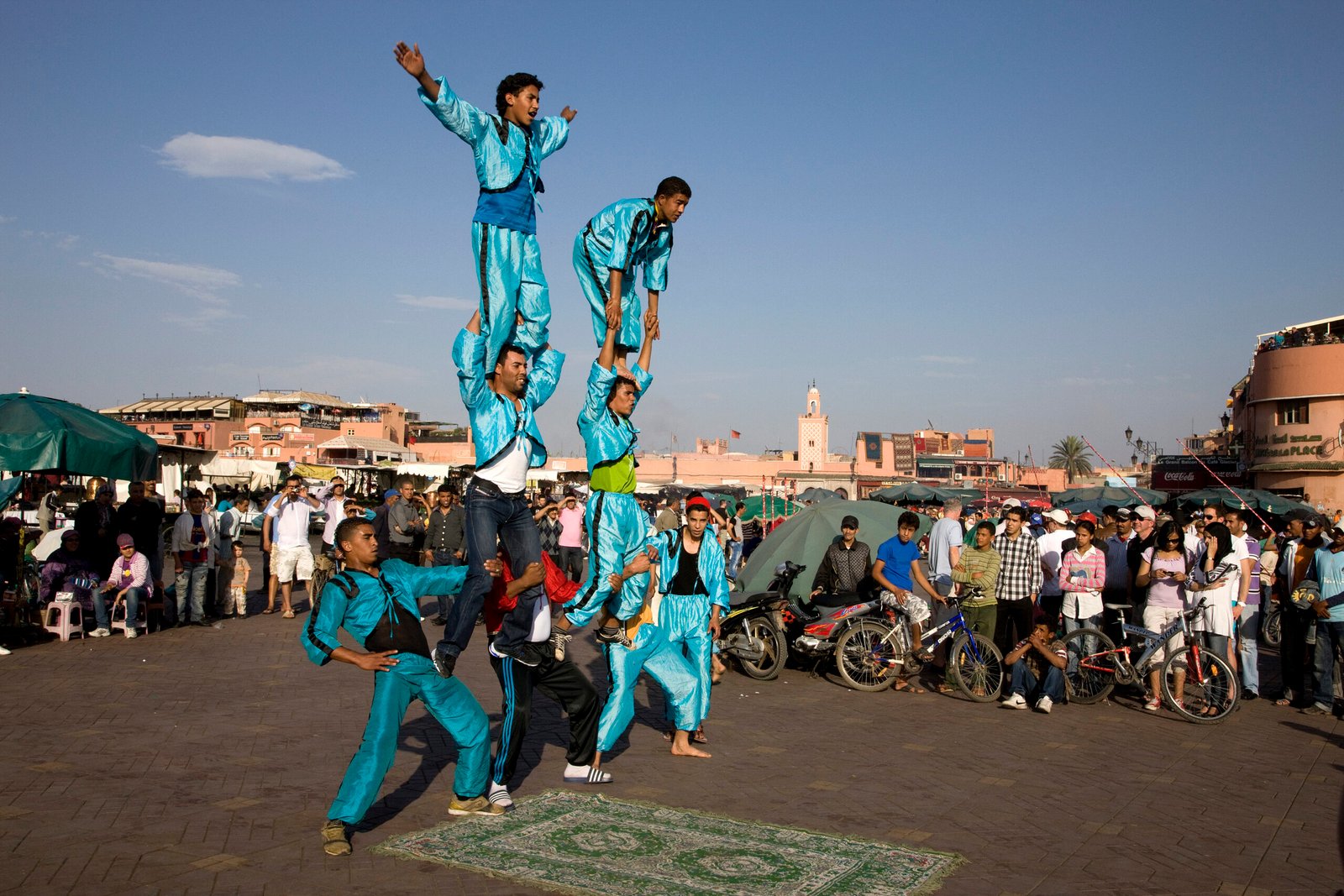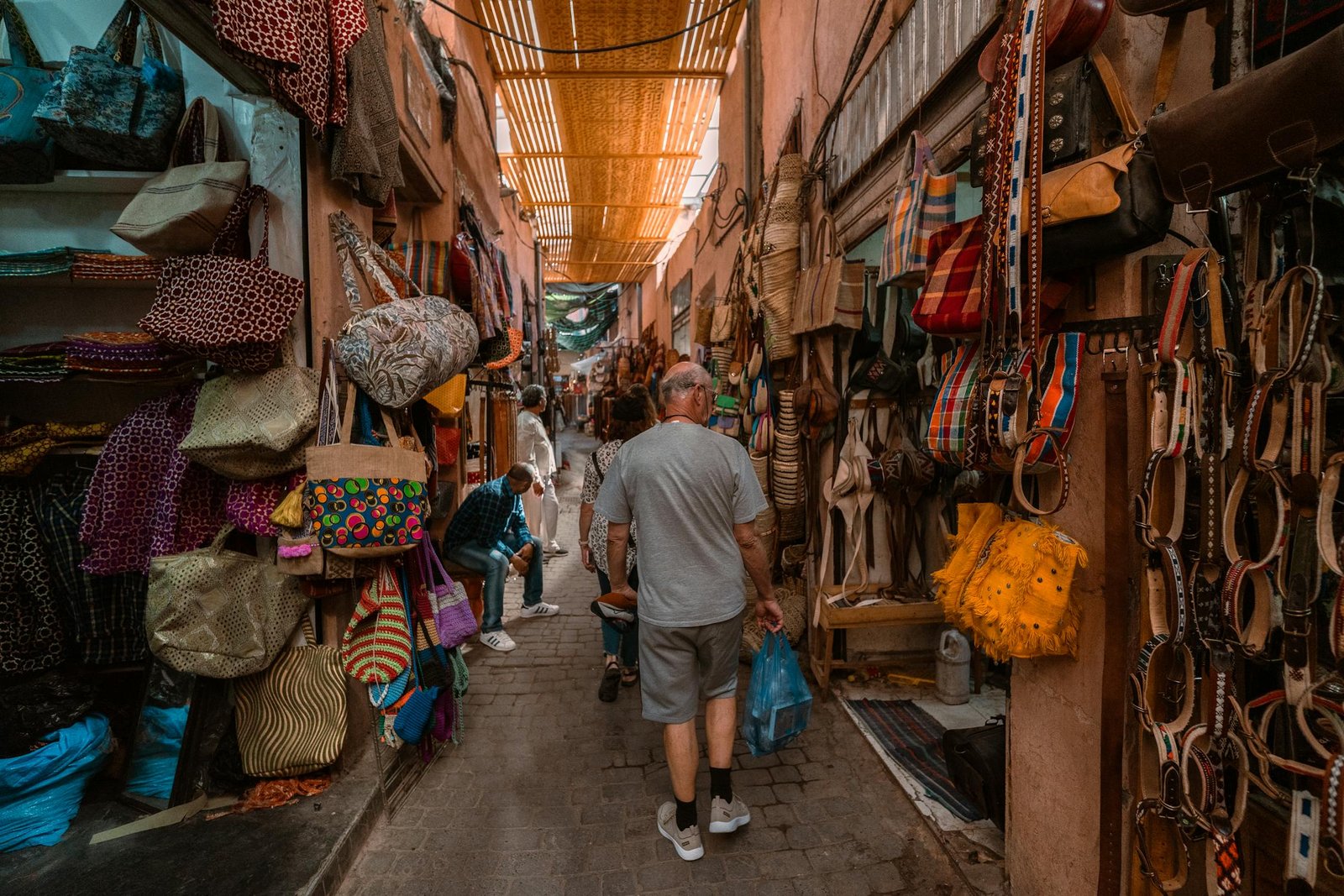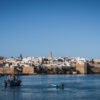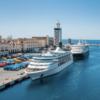Blue runs throughout Riad Romeo, the latest project of the great Italian designer Romeo Gigli, in the Marrakesh medina. It’s on the hand-carved kitchen doors, in horizontal lines on the sand-coloured walls, in the abstract painted peacocks guarding the stairs. It’s the same blue you see everywhere in Marrakesh — in the tiles, on the tombs of dead Moroccan princes, dyed in the robes worn on every street corner. It’s the colour of a desert sky or Paul Newman’s eyes.
Given Gigli’s avant-garde designs it’s not surprising that Riad Romeo, a five-bedroom pensione opened in 2024, is hardly a typical Moroccan riad. Yes, it is peaceful, despite the desperate barter of the souk only a minute’s walk away, but there are no palm trees or blue-and-white checked mosaics. Instead, it’s all abstract minimalism, as if you are inside the creative mind of a genius. What’s more, the genius himself is very much around.
“I wanted to build a quiet space like in the middle of the desert,” Gigli says, breaking off from supervising the installation of strips of mirrored glass in the hall to reflect blue strips on to the opposite walls. “And the first step was colours. This sandy colour, with little lines, like the desert.”

He points at the marbled veins of the floor. The local blue, according to his daughter Diletta, 27, a competitive showjumper who runs the riad, is called “majorelle”. She adds: “But my father mixes the colours himself.”
Gigli was a celebrated fashion designer of the Eighties and Nineties. His clients included Nicole Kidman, Bianca Jagger and Princess Caroline of Monaco, with shops in Paris, Milan and New York.. According to Harper’s Bazaar, Gigli’s designs are having a renaissance. He’s now one of the top-selling vintage designers and Simone Bellotti, the creative director of Bally, said that Gigli was the main influence for his hit catwalk show last autumn.
Now in his mid-seventies, Gigli first came to Marrakesh 40 years ago when he fell out of love with Ibiza. “It had just become ghastly after they opened the casino,” says Gigli, the son of an Italian countess and an antiquarian book dealer.

Gigli’s not the first designer to be attracted to Marrakesh. Yves Saint Laurent not only lived here but his former partner founded the city’s Yves Saint Laurent Museum. Jasper Conran has also recently opened L’Hotel Marrakesh, but, rather like the difference between their clothes, Gigli tends to the fantastically cool whereas Conran is far more conventional.
• Morocco travel guide
Everywhere you look in Riad Romeo there’s something outlandishly beautiful that shows his theatrical mind. The courtyard fountain, rather than being the standard central oblong or garden-ornament oval, is a wall-tiled two-storey gold-green face of a desert queen inspired by geometric African tribal art. Her left earring, a medusa lamp made from 6ft tendrils of translucent blue, is a collaboration between Gigli and one of Italy’s top sculptors, Jacopo Foggini, as are the great dribbles of amber oozing down the staircase walls, the same colour as the Moroccan honey we glooped on our breakfast yoghurt. The horizontal zigzag banisters are locally made, like the fabrics and almost everything in the riad. The rooms are beautiful, airy, comfortable; the food, a mixture of traditional Moroccan and Italian, delicious. Gigli says: “The furniture, the textiles, the glasses, the ingredients … everything is local. I design and I work with local artisans.”

Shopping, of course, is the point of Marrakesh. Writers gush over this rose-red international market with a city attached, blooming out of the desert and the snow-capped Atlas Mountains. This is my first trip to the city and, to be honest, it takes me a while to get into Marrakesh. We land at night, which made sense when leaving the UK, but results in an underwhelming arrival. It is pitch black, which means neither the desert nor the snow-capped mountains can be seen. The red walls rear over us as, buffeted by mopeds, we walk the narrow-roofed alleyways. I can feel the claustrophobia rising. I also hadn’t wanted to do too much shopping on this trip — I’m a serious shopper and our flat is full from 30 years of assignments: carpets from Baghdad, Kabul and Sarajevo, Korean vases and Turkish bowls, Piranesi prints of Rome, antique coats from Samarkand and Bukhara, a red velvet banner embroidered with the face of Lenin and “Workers of the world, unite! You have nothing to lose but your chains!” and other anachronistic slogans. I hadn’t got space for any more stuff, I thought.
• 15 of the best riads in Marrakesh for 2025
But the next evening, drinking mint tea on the roof terrace of the Café de France (instagram.com/cafedefrancemarrakech), the mountains finally visible in the dying sun, we watch Marrakesh’s gorily named great square, Djemaa el-Fna (Place of Execution), fill up with vendors selling fruit, bags, plates and sparkly sandals, spice bins heaped in burnt orange and beige, lanterns flickering through the gathering gloom, aquamarine plates, piles of leather holdalls. It is all so beautiful and so very cheap. I turn to my husband, knocking back his Casablanca beer, and say: “Now I get it.”
Gigli, meanwhile, is full of tips on what glasses, ceramics and carpets to buy. Diletta takes us to their favourite local glass and ceramic shops, just round the corner in the souk — Riad Romeo’s own boutique, selling his clothes and locally made ceramics, is due to open just after we leave. Thanks to the security guard at the 19th-century Bahia Palace (formerly the grand vizier’s residence), we discover a nameless old-fashioned bag shop in the Mellah, the old Jewish quarter wiggling off the main souk, where father and son make and sell bags on site. We return several times and buy a lot of luggage, which we need simply to put all our other purchases in.

Diletta sends us to Al Baraka, a restaurant in a fabulous old pasha’s palace, just off Djemaa el-Fna (mains from £8; albaraka-marrakech.com). In a palm and fruit-tree filled courtyard, tiled with as many blue-and-white mosaics as anyone could want, musicians play and dance as we struggle to finish the multicourse “pasha’s menu”: meat pastries, salads bursting with coriander, lemon and beetroot, lamb and prune tagines, sliced caramelised oranges, little pastries stuffed with orange blossom-scented almonds and so on. “Was the pasha very fat?” I ask the waiter. “Very, very fat!” he replies.
After several days of shopping, our room at Riad Romeo is piled with leather bags, sponge bags, multicoloured loafers in the softest leather, Moroccan slippers, a jewellery box and blue glasses like Gigli’s. We’d resisted the carpets as we don’t have enough floor space in London. The only thing we haven’t bought, zigzagged coffee cups aside, are ceramics. The choice is overwhelming: big bowls, small bowls, huge platters, white with blue and red tracery from Fez, gleaming forest green or creamy yellow with black. All are lovely but nothing has totally grabbed me and they aren’t exactly cheap.
It is on the drive to Essaouira, on the coast, the following day that we see a man selling plates beside the road. I leap out and start haggling, then return with a soup tureen, eight soup bowls, a huge platter, three large bowls, two jugs and a butter dish — all for the price of a couple of salad bowls in Marrakesh. “How on earth are you going to get that lot home?” my husband asks. “I’ll buy another bag,” I reply. In fact I have to buy two — and one of them is the deepest Moroccan blue.










